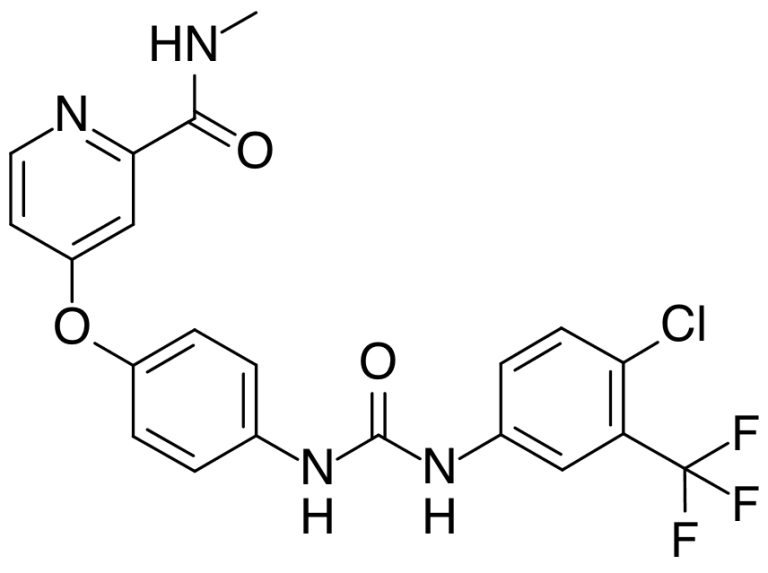服务热线
021-60498804
产品中心
/ Products Classification 点击展开+
| Cat. Number | S5868 |
| Chemical Name | S5868 SORAFENIB 284461-73-0 |
| CAS Number | 284461-73-0 |
| Mol. Formula | C21H16ClF3N4O3 |
| Mol. Weight | 464.82 |
| Qty 1 |
25mg |
| Qty 2 | 100mg |
| Appearance | White to off white powder |
| Application Notes | ≥98% |
| Synonym | 4-[4-[[4-chloro-3-(trifluoromethyl)phenyl]carbamoylamino]phenoxy]-N-methyl-pyridine-2-carboxamide, BAY 43-9006 |
| Melting Pt. | 202-204°C |
| Solubility | DMSO 127mg/mL, water:0.01mg/mL |
| Storage condition | Ambient |
| References | Sorafenib is an inhibitor of c-Raf, Ret, and VEGFR2 that is currently used clinically to treat renal cell carcinoma and hepatocellular carcinoma, as well as other advanced cancers. Sorafenib exhibits anticancer chemotherapeutic, anti-angiogenic, and immunosuppressive activities. In osteosarcoma cells, sorafenib inhibits cell proliferation by downregulating expression of ERK and VEGFR2 and inhibiting phosphorylation of VEGFR2, RET, and MEK1. In cellular and animal models of lymphoma, sorafenib inhibits phosphorylation of MAPKs and PI3K/Akt, decreasing vessel density and increasing apoptotic cell death. Sorafenib also inhibits the epithelial-to-mesenchymal transition (EMT) in epithelial cells and potentiates histone acetylation. In hepatoma cells, this compound decreases levels of enhancer of zeste homolog 2 (EZH2) and inhibits histone methyltransferase (HMT) activity, inducing apoptosis. In animal models, sorafenib inhibits tumor growth, increases tumor-specific T cells, and decreases CD8+ and Treg T cell functions by inducing T cell apoptosis. Additionally, sorafenib inhibits phosphorylation of STAT3/5. ReferencesMei J, Zhu X, Wang Z, et al. VEGFR, RET, and RAF/MEK/ERK Pathway Take Part in the Inhibition of Osteosarcoma MG63 Cells with Sorafenib Treatment. Cell Biochem Biophys. 2013 Dec 31. [Epub ahead of print]. PMID: 24375110. Chen ML, Yan BS, Lu WC, et al. Sorafenib relieves cell-intrinsic and cell-extrinsic inhibitions of effector T cells in tumor microenvironment to augment antitumor immunity. Int J Cancer. 2013 Jul 2. [Epub ahead of print]. PMID: 23818246. Wang S, Zhu Y, He H, et al. Sorafenib suppresses growth and survival of hepatoma cells by accelerating degradation of enhancer of zeste homolog 2. Cancer Sci. 2013 Jun;104(6):750-9. PMID: 23421437. Zhang J, Chen YL, Ji G, et al. Sorafenib inhibits epithelial-mesenchymal transition through an epigenetic-based mechanism in human lung epithelial cells. PLoS One. 2013 May 31;8(5):e64954. PMID: 23741434. Carlo-Stella C, Locatelli SL, Giacomini A, et al. Sorafenib inhibits lymphoma xenografts by targeting MAPK/ERK and AKT pathways in tumor and vascular cells. PLoS One. 2013 Apr 19;8(4):e61603. PMID: 23620775. Panka DJ, Wang W, Atkins MB, et al. The Raf inhibitor BAY 43-9006 (Sorafenib) induces caspase-independent apoptosis in melanoma cells. Cancer Res. 2006 Feb 1;66(3):1611-9. PMID: 16452220. |





